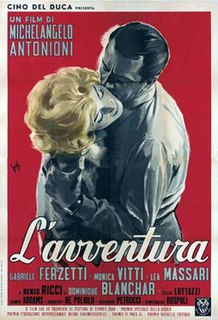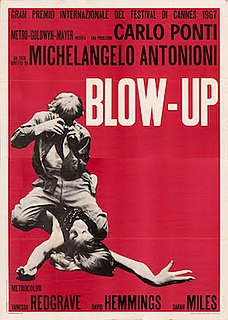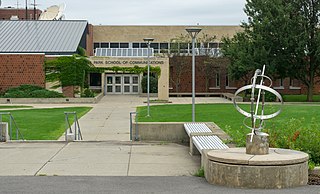
Michelangelo Antonioni was an Italian film director, screenwriter, editor, and painter. He is best known for his "trilogy on modernity and its discontents" — L'Avventura (1960), La Notte (1961), and L'Eclisse (1962) — as well as the English-language films Blowup (1966) and The Passenger (1975). His films have been described as "enigmatic and intricate mood pieces" that feature elusive plots, striking visual composition, and a preoccupation with modern landscapes. His work would substantially influence subsequent art cinema.

L'Avventura is a 1960 Italian drama film directed by Michelangelo Antonioni. Developed from a story by Antonioni with co-writers Elio Bartolini and Tonino Guerra, the film is about the disappearance of a young woman during a boating trip in the Mediterranean, and the subsequent search for her by her lover and her best friend. It was filmed on location in Rome, the Aeolian Islands, and Sicily in 1959 under difficult financial and physical conditions. The film is noted for its unusual pacing, which emphasizes visual composition, mood, and character over traditional narrative development.

David Edward Leslie Hemmings was an English actor, director, producer, and singer-songwriter. He co-founded the Hemdale Film Corporation in 1967.

Blowup is a 1966 mystery thriller film directed by Michelangelo Antonioni and produced by Carlo Ponti. It was Antonioni's first entirely English-language film, and stars David Hemmings as a London fashion photographer who believes he has unwittingly captured a murder on film. The film also stars Vanessa Redgrave, Sarah Miles, John Castle, Jane Birkin, Tsai Chin, Peter Bowles, and Gillian Hills, as well as 1960s model Veruschka. The film's plot was inspired by Julio Cortázar's short story "Las babas del diablo" (1959). The screenplay was by Antonioni and Tonino Guerra, with English dialogue by British playwright Edward Bond. The cinematographer was Carlo di Palma. The film's non-diegetic music was scored by jazz pianist Herbie Hancock, while rock group the Yardbirds also feature. The film is set within the mod subculture of 1960s Swinging London.

Red Desert is a 1964 Italian film directed by Michelangelo Antonioni and starring Monica Vitti with Richard Harris. Written by Antonioni and Tonino Guerra, it was Antonioni's first color film. The story follows a troubled woman (Vitti) living in an industrial region of Northern Italy following a recent automobile accident.

The UCLA School of Theater, Film and Television, is one of the 12 schools within the University of California, Los Angeles (UCLA) located in Los Angeles, California. Its creation was groundbreaking in that it was the first time a leading university had combined all three of these aspects into a single administration. The undergraduate program is often ranked among the world's top drama departments. The graduate programs are usually ranking within the top three nationally, according to the U.S. News & World Report. Among the school's resources are the Geffen Playhouse and the UCLA Film & Television Archive, the world's largest university-based archive of its kind, celebrating its 50th anniversary in 2015. The Archive constitutes one of the largest collections of media materials in the United States — second only to the Library of Congress in Washington, D.C. Its vaults hold more than 220,000 motion picture and television titles and 27 million feet of newsreel footage. The film, television, and digital media program is one of the most prestigious film programs in the world. It is the most selective film school as the film and television major selects about only 15 freshman out of thousands of applicants and a handful of transfer students.

Zabriskie Point is a 1970 American drama film directed by Michelangelo Antonioni and starring Mark Frechette, Daria Halprin, and Rod Taylor. It was widely noted at the time for its setting in the counterculture of the United States. Some of the film's scenes were shot on location at Zabriskie Point in Death Valley. The film was an overwhelming commercial failure, and was panned by most critics upon release. Its critical standing has increased, however, in the decades since. It has to some extent achieved cult status and is noted for its cinematography, use of music, and direction.

Monica Vitti is an Italian actress best known for her starring roles in films directed by Michelangelo Antonioni during the early-to-mid 1960s. After working with Antonioni, Vitti changed focus and began making comedies, working with director Mario Monicelli on many films. She has appeared with Marcello Mastroianni, Alain Delon, Richard Harris, Terence Stamp, Michael Caine, and Dirk Bogarde.

La Notte is a 1961 Italian drama film directed by Michelangelo Antonioni and starring Marcello Mastroianni, Jeanne Moreau and Monica Vitti. Filmed on location in Milan, the film is the relationship between a disillusioned novelist and his frustrated wife as it follows a single day and night where they confront their alienation from each other and the empty Milan circles they travel. The film continues Antonioni's tradition of abandoning traditional storytelling in favor of visual composition.
Vivian Carol Sobchack is an American cinema and media theorist and cultural critic.

Still Life is a 2006 Chinese film directed by Jia Zhangke. Shot in the old village of Fengjie, a small town on the Yangtze River which is slowly being destroyed by the building of the Three Gorges Dam, Still Life tells the story of two people in search of their spouses. Still Life is a co-production between the Shanghai Film Studio and Xstream Pictures.

The Roy H. Park School of Communications is one of five schools at Ithaca College, in Ithaca, New York, United States. The school is named after media executive Roy H. Park, who lived in Ithaca and who served on the board of trustees at Ithaca College for many years.
Emanuel Levy is an American film critic and professor who has taught at Columbia University, New School for Social Research, Wellesley College, Arizona State University and UCLA Film School. Levy currently teaches in the department of cinema studies at New York University.

Story of a Love Affair is a 1950 Italian drama film directed by Michelangelo Antonioni and starring Massimo Girotti and Lucia Bosè. Despite some neorealist background, the film was not fully compliant with the contemporary Italian neorealist style both in its story and image, featuring upper-class characters portrayed by professional actors. Ferdinando Sarmi was, however, a fashion designer rather than a professional actor. Its story was inspired by the James M. Cain novel The Postman Always Rings Twice. In the film, the camera pans the same street corner in Ferrara, the director's native city, that appears in his film Beyond the Clouds forty-five years later. In 1951, the film won the Nastro d'Argento Silver Ribbon Award for Best Original Score and the Special Silver Ribbon for human and stylistic values. Story of a Love Affair was Antonioni's first full-length feature film.

Clayborne Carson is a professor of history at Stanford University, and director of the Martin Luther King, Jr., Research and Education Institute. Since 1985 he has directed the Martin Luther King Papers Project, a long-term project to edit and publish the papers of Martin Luther King Jr.

Pier Maria (P.M.) Pasinetti was a novelist, professor and journalist.
European art cinema is a branch of cinema that was popular in the latter half of the 20th century. It is based on a rejection of the tenets and techniques of classical Hollywood cinema.
Marsha Kinder is an American film scholar and Professor of Critical Studies at the University of Southern California.

The 5th Yerevan Golden Apricot International Film Festival was a film festival held in Yerevan, Armenia from 13–20 July 2008. The festival had more than 450 submissions from 67 countries; viewers had an opportunity to see over 160 films. Among the honorable guests of the festival were Wim Wenders, Enrica Antonioni, Goran Paskaljevic, Dariush Mehrjui, Catherine Breillat, and others. A Special Tribute was paid to Michelangelo Antonioni by honoring him with a posthumous Parajanov’s Thaler. Additionally, Wim Wenders and Dariush Mehrjui were honored with Parajanov’s Thaler Lifetime Achievement Awards. The main prizewinners of the 5th Golden Apricot were Anna Melikian from Russia for her film The Mermaid, Meira Asher from Israel for the film Women See Lot of Things, and Eric Nazarian from the USA for The Blue Hour. The FIPRESCI Award went to Huseyn Karabey with his film My Marlon and Brando and the Ecumenical Award to Eric Nazarian with his film The Blue Hour.
Robert A. Hill is a Jamaican historian and academic who moved to the United States in the 1970s. He is Professor Emeritus of History and Research Professor at the University of California, Los Angeles (UCLA), and Visiting Fellow at The Sir Arthur Lewis Institute of Social and Economic Studies (SALISES), University of the West Indies at Mona, Jamaica. A leading scholar on Marcus Garvey, Hill has lectured and written widely on the Garvey movement, and has been editor-in-chief of The Marcus Garvey and Universal Negro Improvement Association Papers for more than 30 years. Reviewing the first volume in 1984, Eric Foner wrote: "'The Marcus Garvey and Universal Negro Improvement Association Papers' will take its place among the most important records of the Afro-American experience."














